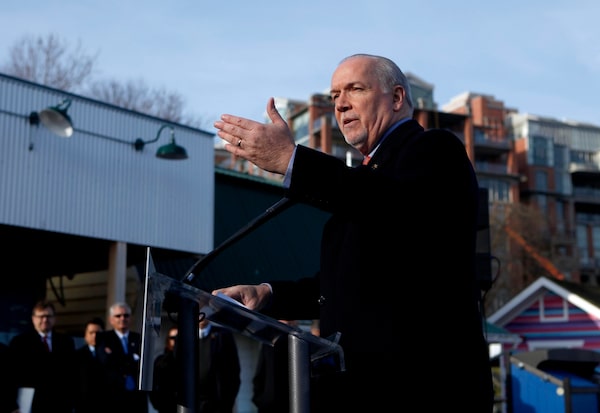
Premier John Horgan makes an announcement in Victoria, B.C., on March 15, 2019.CHAD HIPOLITO/The Canadian Press
The Hupačasath First Nation on Vancouver Island started selling electricity from their run-of-river facility to BC Hydro in 2005. They are still paying off the debt from that $14-million investment, but the job-creating venture has been a model for Indigenous clean-energy opportunities. Now, BC Hydro is signalling it may not renew the contract in 2025 – just as the project is expected to finally deliver solid profits to the community.
The province says it doesn’t need all the 131 independent power projects that it currently has signed on.
Near Williams Lake, Morehead Valley Hydro – another microhydro power producer that has been selling power to BC Hydro for three decades – has already been told the Crown-owned utility is walking away.
In the past 12 months, BC Hydro has chosen to let three energy purchase agreements expire without renewal.
“We have a surplus of supply at the present time,” Premier John Horgan told reporters last week.
In fact, B.C. was on track to be a net importer of electricity last year. Drought and cold weather drove demand beyond BC Hydro’s supply. But that’s not the preferred narrative of Mr. Horgan, who once described these small independent producers as the purveyors of “junk power.” He has long favoured public ownership and control of the province’s electricity resources.
His government recently released a report that concluded BC Hydro customers will pay $16-billion over the next two decades because the Crown utility was pressed by the former government to sign contracts with independent power producers. While industry has argued the report is flawed, it confirmed what Mr. Horgan has long believed.
“The previous government chose the parent-knows-best approach to creating energy supply, and the consequence of that are billions and billions of dollars that are left on the table, or even worse, leaving the province elsewhere for shareholders rather than coming into the public treasury to meet the demands of more supply,” Mr. Horgan said.
But surpluses and shortfalls of electricity come and go in B.C., and with the government’s commitment to a climate action plan that aims to wean British Columbians off fossil fuels, new demand is expected to far outstrip supply, even with the construction of the $10.7-billion Site C hydroelectric dam that his government has approved.
The decision to move ahead with Site C, which had started construction under the former Liberal government, was a devastating blow to Indigenous communities that have looked to renewable energy as an industry that can help them work toward self-sufficiency, said Judith Sayers, President of the Nuu-chah-nulth Tribal Council. Ms. Sayers was instrumental in building the Hupačasath’s power project when she served as elected chief of that community.
“They knew, when they made the decision on Site C, that they would be cutting First Nations off of opportunities," she said. “It’s the worst thing I have ever seen with this government.”
Ms. Sayers continues to work with First Nations around the province on clean energy projects, but she wonders about carrying on. “They are killing an industry, and they are killing opportunity for First Nations.”
Clean BC, the province’s road map to meet targets to reduce greenhouse gas emissions, calls for the electrification of transport, buildings and industry. In addition, the proponents of the Chevron-Woodside Kitimat LNG project announced last week their intent to build the proposed facility using electric drive technology. The one project alone could use two-thirds of all the energy provided by Site C, according to Jihad Traya, an energy adviser for Solomon Associates.
Martin Mullany, executive director of Clean Energy BC, which represents independent power producers, said over the past decade, BC Hydro has been a net importer of electricity for as many years as it has been a net exporter.
And that is without accounting for the massive shift from fossil fuels to electric power that Clean BC envisions over the coming decade. The plan, announced in December, promises to touch every part of the economy from home heating to heavy transportation, using the province’s supply of clean hydro-electric power to help shift individuals and industry off their reliance on the fossil fuels that currently make up two-thirds of B.C.'s energy consumption.
The message from the NDP government to the renewable energy industry, however, is that they are not welcome in B.C. right now, Mr. Mullany said.
“The independent power producers in B.C. are willing to work with government to reach its goals for Clean BC, but its going to be very hard to get money into B.C. in the current environment,” he said. “Nobody is going to start investing in project development at the moment, it’s just a high risk jurisdiction.”
 Justine Hunter
Justine Hunter